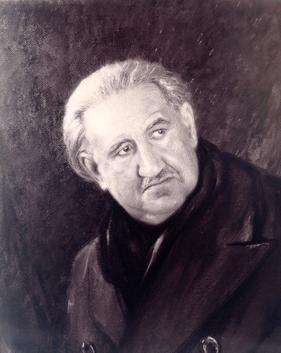Manolis Kalomiris facts for kids
Manolis Kalomiris (born December 14, 1883, died April 3, 1962) was a famous Greek classical composer. He is known for starting the Greek National School of Music. This was a special way of composing music that mixed Greek traditions with Western styles.
Contents
Early Life and Education
Manolis Kalomiris was born in Smyrna, which is now Izmir, Turkey. He went to school in Constantinople (modern Istanbul). Later, he studied piano and how to compose music in Vienna, a city famous for its music.
Building Greek Music
After his studies, Kalomiris worked for a few years as a piano teacher in Kharkov, which was then part of the Russian Empire. He later moved to Athens, Greece, where he settled down.
Kalomiris greatly admired other famous composers like Richard Wagner and Nikolai Rimsky-Korsakov. He also loved the writings of Greek poets and authors such as Kostis Palamas and Nikos Kazantzakis.
His biggest goal was to create a unique Greek "national school" of music. He wanted this music to combine ideas from Russian national composers, Western music styles, and traditional Greek folk music, poetry, and myths.
Founding Music Schools
To achieve his dream, Manolis Kalomiris founded two important music schools:
- In 1919, he started the Hellenic Conservatory.
- In 1926, he founded the National Conservatoire.
At the same time, he also worked as the main supervisor for military bands across Greece. He held many public jobs and was even chosen to be a member of the Academy of Athens.
His Musical Style
Manolis Kalomiris was a very passionate composer. His music often sounds "post-romantic," which means it has rich and full sounds, with many different instruments playing together. He used complex counterpoint, which is when different melodies play at the same time.
His music also featured long, flowing melodies that sounded like music from Eastern countries. He often used rhythms found in traditional Greek folk music. Kalomiris wrote many different types of music, including:
- Three symphonies (large musical pieces for an orchestra).
- Five operas (musical plays with singing).
- One piano concerto (a piece for piano and orchestra).
- One violin concertino (a shorter piece for violin and orchestra).
- Other works for orchestra.
- Chamber music (music for a small group of instruments).
- Many songs and piano pieces.
His operas often explored themes of strong feelings and life's big questions.
See also
 In Spanish: Manolis Kalomiris para niños
In Spanish: Manolis Kalomiris para niños


